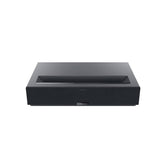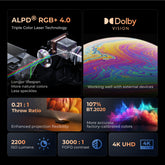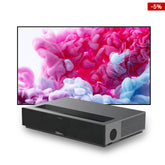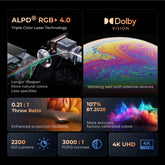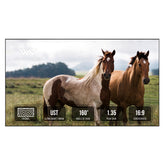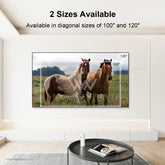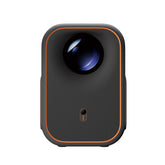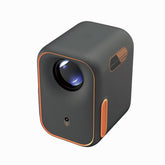Projector Screen vs White Wall: The Aussie Buyer’s Guide
Home Theatre • Australia
Projector Screen vs White Wall: What Actually Works Best in Aussie Homes?
If your projector sometimes looks sharper on a wall than on a cheap screen, you’re not imagining it. Here’s why it happens in Australian homes — and how a daylight-viewable ALR screen fixes it.
 Daylight-viewable ALR screens keep blacks black in bright Aussie living rooms.
Daylight-viewable ALR screens keep blacks black in bright Aussie living rooms.Why a White Wall Can Beat a Cheap Screen (Sometimes)
Many Aussie living rooms are bright, open-plan spaces. In those conditions, low-grade PVC or fabric screens with uneven texture scatter light (messy diffuse reflection), which reduces contrast and fine detail. A smooth, matte wall can reflect more evenly in a dim room, so it may look “cleaner” than a bargain screen.
- Uniform, fine texture (no grain or sparkle)
- Spectrally neutral coating (accurate colour)
- True matte or controlled gain (no hot spots)
- Tensioned surface to stay perfectly flat
Tip: If you can feel grain or see waves in daylight, the surface is the problem.
Ambient Light: The Real Aussie Villain
Downlights, skylights and big windows wash out the image on basic white screens with no ambient-light rejection. You’re seeing the projector’s picture plus reflected room light — blacks lift to grey, colours fade.
A slightly matte, light-grey wall can sometimes look better than a shiny white screen because it bounces less stray light. But there’s a better fix: daylight-viewable (ALR/CLR) screens use engineered micro-structures to reflect projector light toward you while deflecting ambient light from above and the sides — ideal for Aussie daylight.
Installation & Setup: Where Sharpness Is Won (or Lost)
- Geometry first, keystone last — centre the lens and keep it parallel; use lens shift/zoom before any digital keystone.
- Refocus after warm-up — most projectors sharpen after a few minutes.
- Kill direct light on the screen; keep lamps behind you or use dim bias lighting.
- Tension matters — fixed-frame or tab-tensioned motorised screens avoid “waves”.
When the Wall Is a Smart Choice
- You watch mostly at night and can control lights.
- The wall is smooth, matte and light neutral grey (boosts perceived contrast).
- You’re renting or testing sizes before investing.
Paint tip: choose flat/matte interior; avoid gloss or heavy textures that cause hotspots.
When a Proper Screen Wins (Every Time)
- Daylight or mixed lighting: choose ALR/CLR.
- Ultra-short-throw (UST): use UST-specific CLR; standard screens or walls wash out at steep angles.
- Big sizes (100″+): a fixed-frame screen keeps uniform focus and geometry.
- Colour accuracy: quality screens are spectrally neutral for skin tones and HDR grades.
Simple 15-Minute A/B Test at Home
- Night test: curtains shut, lights off. Project half on wall, half on screen (use a high-contrast test slide).
- Day test: repeat with blinds open (typical Aussie daytime).
- Score: black level, shadow detail, uniformity (no hot spots), edge sharpness.
- Tune: square the projector, reduce digital keystone, refocus. If the screen still loses, upgrade to ALR/CLR or better material.
Choosing the Right Screen for Australia (Fast Guide)
| Factor | Recommendation |
|---|---|
| Room brightness | Dark/dimmable: matte white/light-grey (gain ~1.0). Mixed/daylight: ALR/CLR. |
| Projector type | Standard throw: ALR for bright rooms, matte for dark. UST (laser TV): UST-specific CLR only. |
| Size & seating | Rule of thumb: viewing distance ÷ 3 ≈ screen height. Confirm throw coverage. |
| Build | Fixed-frame or tab-tensioned motorised for long-term flatness. |
Troubleshooting (Before You Spend)
- Hot spots/glare → drop brightness a notch, ensure matte surface, check geometry.
- Washed out in the day → step up to ALR/CLR and control direct light.
- Soft edges → reduce digital keystone, re-align, refocus after warm-up.
- Wavy bands → the surface isn’t flat; you need tensioning or a new screen.
Why ForMovies Screens Are Built for Aussie Daylight
Australia loves airy, sunlit spaces. Our daylight-viewable ALR/CLR screens are engineered to keep contrast and colour clear in daylight, not just in a blackout room. Pair one with proper setup and you’ll enjoy cinema-grade clarity without shutting the house down.
Get matched to the right daylight-viewable ALR screen for your room, projector and budget.
Professional Corner (for Integrators & Installers)
- ALR geometry: verify projector elevation vs the screen’s rejection angle; avoid ceiling can lights within the rejection cone.
- Spectral neutrality: target ΔE < 3 post-calibration; avoid pearlescent gains that twist colour volume.
- Uniformity: aim centre-edge luminance variance ≤ 15% at operating brightness.
- Mounting: specify rigid frames at ≥ 100″; for motorised, use tab-tensioned with lateral guides.
- Commissioning: calibrate after 30–60 min warm-up; verify HDR tone-mapping with mixed APL content.
Trade & Pro Install — enquiries welcome.
FAQ: Projector Screens vs White Wall in Australia
Why does my projector look better on a white wall than my screen?
Some budget screens have uneven texture or aren’t tensioned, scattering light and lowering contrast. A smooth, matte wall can look cleaner in a dark room.
Do I need an ALR screen for a bright Aussie living room?
If you watch with blinds open or lights on, yes. ALR/CLR screens reject ambient light so blacks stay black and colours stay saturated.
Is a matte grey wall a good compromise?
For night viewing it can help black levels. For daytime viewing, an ALR/CLR screen will outperform any paint.
I have a UST (laser TV). What screen should I buy?
A UST-specific CLR screen. Standard white or generic ALR won’t manage the steep projection angle.
Fixed frame or motorised?
Fixed-frame is the flattest. If you prefer retractable, choose a tab-tensioned motorised screen for long-term flatness.











